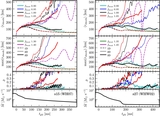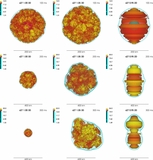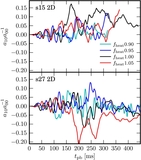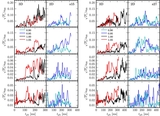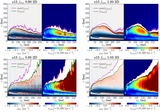Image Details

Caption: Figure 6.
Spherical harmonic coefficients, a ℓ m , for the first Legendre order, ℓ = 1, in the 2D and 3D non-exploding simulations ( f heat = 1.00, left) and critical-case explosion simulations ( f heat = 1.05, right) for s15 (top) and s27 (bottom). For the 2D cases (thin blue lines) we show the data for f heat = 0.90 (left) and f heat = 0.95 (right). Strong periodicity with growing amplitude is seen at certain times in all of these simulations, strongly indicative of SASI activity. For s15 in the non-exploding cases (top, left) the SASI activity is clearly stronger in 3D than in 2D. In the exploding case for s15 (top right), the SASI is dramatically diminished in 3D yet strengthened in 2D. s27 in the non-exploding cases (bottom left) is very favorable to the SASI during two distinct epochs in 3D: early on while the mass accretion rate is still quite high, and later ( t pb > 300 ms), at which point the shock has receded to small radii. For s27 f heat0.90 2D, only the early epoch shows clear SASI activity, while the later, postshock recession SASI is extremely muted relative to 3D. In the exploding cases for s27, both 2D and 3D show low-frequency SASI activity up until ~200 ms, after which the models transition to explosion and the SASI is no longer in evidence.
Copyright and Terms & Conditions
© 2014. The American Astronomical Society. All rights reserved.


